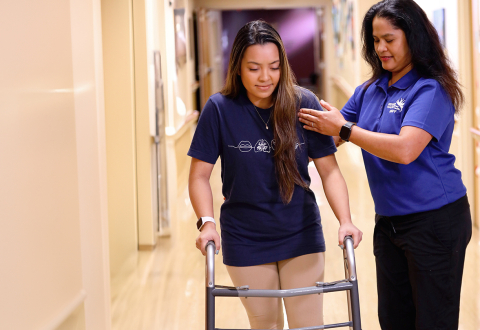
After a stroke, the world can feel overwhelming. After a patient’s acute stay, one of the most critical decisions their family will face is choosing the next step for rehabilitation. You might hear different terms like "nursing home," "skilled nursing," or "rehab." But there is one that stands above the rest for stroke recovery: the Inpatient Rehabilitation Facility, or IRF.
Understanding what an IRF is—and what it isn't—is crucial for giving a stroke survivor the best possible chance at regaining their independence. As Hawaii's only certified IRF, we want to make this choice clear.
Capitalizing on the Brain's "Golden Window"
The single most important concept in stroke recovery is neuroplasticity. This is the brain's incredible ability to reorganize itself and form new neural connections to compensate for the areas damaged by a stroke. This ability is at its peak in the first few months following a stroke—a "golden window" for recovery.
An IRF is specifically designed to maximize this window. Think of it as a recovery training camp. The goal isn't just to care for a patient; it's to actively and intensively retrain their brain and body. This is fundamentally different from a Skilled Nursing Facility (SNF), which often focuses on slower-paced, long-term care.
The IRF Difference: Intensity, Expertise, and Teamwork
So what does this intensive approach look like for a stroke survivor? It comes down to three key factors.
1. Therapy Intensity (The 3-Hour Rule) IRFs are required to provide a minimum of 3 hours of therapy per day, at least 5 days a week. For a stroke survivor, this means daily, dedicated sessions focused on:
- Physical Therapy (PT): Things like relearning to walk, improving balance, and rebuilding strength.
- Occupational Therapy (OT): Retraining the skills for daily living, like dressing, eating, and writing.
- Speech Therapy (ST): Recovering language skills (aphasia), addressing swallowing problems (dysphagia), and improving cognitive function.
2. Physician-Led Care In an IRF, your loved one is under the daily care of a physiatrist—a medical doctor who specializes in rehabilitation medicine. They lead the entire care team, manage complex medical issues post-stroke (like spasticity or pain), and adjust the treatment plan in real-time as the patient progresses. This level of specialized medical oversight is unique to the IRF setting.
3. A Coordinated Team Your physiatrist leads a full team of experts who work together. Therapists, rehab nurses, care coordinators, and neuropsychologists all collaborate, ensuring that gains made in physical therapy are incorporated into occupational therapy, and that the patient's medical and emotional needs are met holistically.
At a Glance: IRF vs. SNF for Stroke Recovery
| Inpatient Rehabilitation Facility (IRF) | Skilled Nursing Facility (SNF) | |
|---|---|---|
| Primary Goal | Intensive recovery to return home | Long-term nursing care & slower-paced rehab |
| Therapy Intensity | 3+ hours per day, 5+ days a week | Lower intensity, often a few hours per week |
| Physician Care | Daily oversight by a rehab-focused physician | Physician visits are typically less frequent |
| Proven Outcomes | Higher likelihood of returning home | Often a setting for long-term residency |
The Proof Is in the Outcomes
The evidence is clear: for stroke survivors, the intensity and expertise of an IRF lead to better outcomes. That’s why 83.2% of our patients at REHAB Hospital return directly home to their communities.
Frequently Asked Questions
1. How long is a typical stay in an IRF for stroke? While every patient's journey is unique, a typical stay for a stroke survivor can range from two to four weeks, depending on the severity of the stroke and the rate of progress.
2. Will my insurance cover care at an IRF? Most insurance plans, including Medicare, cover care at a certified IRF when it is deemed medically necessary.
3. What should I pack for my stay? We recommend packing comfortable clothing that is easy to move in, such as sweatpants, shorts, and t-shirts, similar to what you would wear for exercise. Be sure to bring a pair of supportive, closed-toe shoes like sneakers. You should also bring personal toiletries and any items that will make you feel more at home, like family photos.
4. What happens after I'm discharged? Our goal is a seamless transition. Discharge planning begins early and includes the family training mentioned above, home safety evaluations, and a coordinated transfer to outpatient therapy to continue your progress.
The Choice for a Better Outcome
The evidence is clear: for stroke survivors, the intensity and expertise of an IRF lead to better outcomes. That’s why 83.2% of our patients at REHAB Hospital return directly home to their communities.
When your loved one is recovering from a stroke, the road ahead can seem uncertain. But choosing the right facility can make all the difference. Choose the path that offers the most hope, the most expertise, and the best chance of rebuilding a life.
